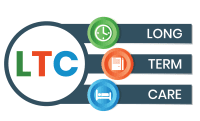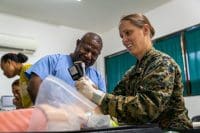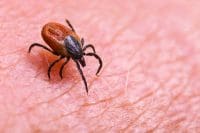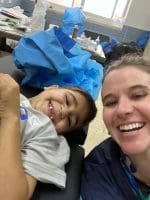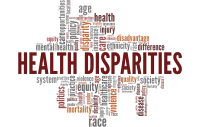Takeaways:
- To help reduce the rise in opioid prescriptions, misuse, and overdose, healthcare professionals must improve their pain management knowledge, decrease opioid prescriptions as appropriate, and provide patients with the education and resources they need to prevent and treat opioid overdoses
- Nurses and other opioid content experts can collaboration with community service organizations to develop and disseminate education about opioids.
The 2015 National Survey on Drug Use and Health (NSDUH) found that 91.8 million U.S. civilian, noninstitutionalized adults used prescription opioids and 11.5 million of those misused them. The Centers for Disease Control and Prevention (CDC) reports that more than 130 people die after an opioid overdose in the United States per day. The rise in opioid prescriptions, misuse, and overdose requires healthcare professionals to improve their pain management knowledge, decrease opioid prescriptions as appropriate, and provide patients with the education and resources they need to prevent and treat opioid overdoses.
To increase knowledge, nurse educators at the University of Arkansas at Little Rock collaborated with MidSOUTH (an organization that provides leadership, training, and product support related to addiction, child welfare, technology, distance learning, and organizational development) to create an educational module about opioid misuse and overdose management and to disseminate it to healthcare professionals for continuing education via a web-based portal.
Curriculum development
The ADDIE (Analysis, Design, Development, Implementation, and Evaluation) model, which promotes evidence-based practice, was used to develop the curriculum for the educational module. The curriculum development team members had backgrounds in opioid management and certification in American Heart Association (AHA) basic life support and advanced cardiac life support. In addition, a social worker provided resources and instruction in therapeutic communication techniques.
The first topic chosen was opioid misuse and overdose management, with the goal of delivering education to healthcare providers and students as early as possible so they have the tools to act quickly in response to suspected opioid overdoses. Four learning objectives were created using Bloom’s taxonomy (a model for ordering cognitive skills), which ranged from knowledge (lower level) to application (moderate level). (See Curriculum overview.)
The following learning objectives and topics were included in the opioid misuse prevention and overdose management educational module.
Learning objectives
The learner will:
- recognize the increase in opioid misuse in Arkansas and understand the implications for first responders, hospital staff, and other community medical providers.
- recognize the signs and symptoms of opioid overdose.
- understand the circumstances in which rescue breathing is appropriate after viewing two methods of rescue breathing in both the community (pocket mask) and hospital settings (bag-mask device).
- know when to administer a nasal or I.V. opioid antidote (naloxone).
Topics
Opioid misuse statistics
- Statewide
- Nationwide
Opioid overdose management
- Assessing for potential overdose
- Administering naloxone
Rescue breathing
- American Heart Association guidelines
Patient education
- Nonjudgmental
- Community resources
- Naloxone administration education
- Correct opioid use
- Alternatives to opioids for pain management
Collaborators and funders of this project also included the Substance Abuse and Mental Health Services Administration, the Arkansas Department of Human Services Division of Behavioral Services, and the State of Arkansas Office of Drug Director.
The nurse educators designed the curriculum, which included a case-based video simulations of a drug overdose in the community and in an emergency department to illustrate the care provided in each setting, including the administration of intranasal and I.V. naloxone. The educators created pre- and post-tests to gauge learner progress and evaluate the module. The educators then shared the completed curriculum with the community service unit leaders along with plans for placing it in an online educational portal and to disseminate it to every nursing program in Arkansas after review by the community service unit’s curriculum team.
In the community: Assessment and rescue priorities
Identifying opioid misuse and recognizing the signs of opioid overdose are essential to successful treatment outcomes. Signs and symptoms of opioid overdose include respiratory depression, pinpoint pupils, extreme sleepiness, inability to talk, cyanosis, and choking or gurgling sounds. Respiratory rate is the priority assessment of patients suspected of opioid overdose; respiratory depression and pinpoint pupils are defining characteristics that result from central nervous system depression.
Treatment priorities in cases of suspected opioid overdose in the community are rescue breathing and naloxone administration. Nasal naloxone should be administered as soon as possible; however, rescue breathing shouldn’t be delayed while waiting to obtain naloxone.
AHA rescue breathing guidelines recommend providing one rescue breath every 5 to 6 seconds (or about 10 to 12 breaths per minute). During rescue breathing, rescuers should check for a pulse approximately every 2 minutes and begin cardiopulmonary resuscitation if a pulse isn’t detected.
Administering naloxone doesn’t replace necessary emergency care. Naloxone lasts only 30 to 90 minutes and opioid effects last much longer, which means that when the naloxone wears off, the overdose could recur. Immediate medical treatment should be sought for all suspected opioid overdoses. (See Opioid overdose: On the scene.)
The following steps align with best practices for opioid overdose identification and management.
Patient responsiveness
- If the patient is unresponsive and not breathing or breathing fewer than eight breaths per minute, begin rescue breathing per American Heart Association (AHA) guidelines.
- Don’t delay rescue breathing, especially if naloxone isn’t readily available (seconds count).
- Activate the emergency response system.
Naloxone unavailable
- Provide rescue breathing per AHA guidelines until naloxone is available; continue assessing the patient’s respiratory status.
Naloxone available
- Administer the first dose of intranasal naloxone (0.4 mg) in tandem with rescue breathing. The maximum intranasal naloxone dose is 2 mg per dose.
- Stay with the patient and continue to administer:
- rescue breathing
- additional doses of naloxone every 2 to 15 minutes (no more than 2 mg per dose) as necessary until emergency medical services arrive or the patient’s breathing rate returns and remains at greater than 8 breaths per minute.
Source: Harm Reduction Coalition.
Experts needed
As the U.S. opioid crisis continues, educating healthcare providers and community members is critical to recognizing and treating overdose. One way to meet that need is for nurses who are opioid content experts to partner with community service organizations to develop and disseminate education on this topic.
Janet Fletcher is an assistant professor at the University of Arkansas at Little Rock. Leigh A. Snead is a clinical educator at the Saline Health System in Benton, Arkansas. Elizabeth Riley is a clinical assistant professor at the University of Arkansas for Medical Sciences in Little Rock.
Selected references
American Heart Association. Highlights of the 2015 American Heart Association Guidelines Update for CPR and ECC. 2015. eccguidelines.heart.org/wp-content/uploads/2015/10/2015-AHA-Guidelines-Highlights-English.pdf
Arkansas Take Back. A national epidemic. artakeback.org/opidemic/a-national-epidemic
Blendon RJ, Benson JM. The public and the opioid-abuse epidemic. N Engl J Med. 2018;378(5):407-11.
Centers for Disease Control and Prevention. CDC WONDER. September 26, 2019. wonder.cdc.gov
Centers for Disease Control and Prevention. Quick Reference for Healthcare Providers: CDC Guideline for Prescribing Opioids for Chronic Pain. cdc.gov/drugoverdose/pdf/Guidelines_Factsheet-a.pdf
Florence CS, Zhou C, Luo F, Xu L. The economic burden of prescription opioid overdose, abuse, and dependence in the United States, 2013. Med Care. 2016;54(10):901-6.
Han B, Compton WM, Blanco C, Crane E, Lee J, Jones CM. Prescription opioid use, misuse, and use disorders in U.S. adults: 2015 National Survey on Drug Use and Health. Ann Intern Med. 2017;167(5):293-301.
Harm Reduction Coalition. Administer naloxone. harmreduction.org/issues/overdose-prevention/overview/overdose-basics/responding-to-opioid-overdose/administer-naloxone
Miglus JD, Froman RD. Evaluation of an evidence-based practice tutorial for nurses: A useful tool and some lessons learned. J Contin Educ Nurs. 2016;47(6):266-71.
Van Zee A. The promotion and marketing of OxyContin: Commercial triumph, public health tragedy. Am J Public Health. 2009;99(2):221-7.
Vowles KE, McEntee ML, Julnes PS, Frohe T, Ney JP, van der Goes DN. Rates of opioid misuse, abuse, and addiction in chronic pain: A systematic review and data synthesis. Pain. 2015;156(4):569-76.






